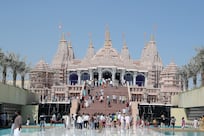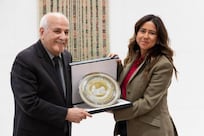Mi Corazón is playing in the conference room of the Armada Hotel in Istanbul and the lobby is full of tango students resting their feet and gabbing about vueltas and pasadas. It's easy to distinguish the dancers from the tourists: just look at their shoes. The women's high heels, trimmed in satin and crystal buckles, have ankle straps to facilitate walking backwards. The men sport snazzy patent leather numbers crested with silver laminate trim and polka dots.
The shoes, perhaps, are one reason that some Turkish men, not generally a sartorially adventurous lot, have reservations about the tango. But that has not stopped Istanbul from becoming, in the past decade, a tango capital to rival any city outside of Buenos Aires. The workshops at the recent four-day Tango Ritual, held at the Armada in the historic Sultanahmet district, were followed by concerts, performances and milongas at night. Organised by the TangoTürk dance school, it is one of the many tango events for which Istanbul - of all places - has become internationally renowned.
Milongas, or traditional Argentine tango parties, take place every night, in luxurious rooftop nightclubs against panoramic views of the glittering skyline of palaces, mosques and minarets. They go on until the early hours of the morning, as if no one had a job to go to (and almost no one does, in this economy). The practicas in schools and clubs throughout the city are always full. The dancing is of the highest standards: the most renowned tango masters from Argentina arrive regularly to give performances and workshops; the maestros Ariadna Naveira and Fernando Sanchez flew in from Argentina for the most recent Ritual. Turkish dancers are fixtures at festivals in Argentina and Europe.
The Istanbul scene is distinguished not so much by its artistic innovation - the style favoured hews closely to the Argentine tradition - as by its unusual friendliness, dynamism and, in particular, its youthfulness. "In Turkey, the tango community is a very young group," says Eser Çakr, a student from the northwestern city of Eskisehir. "In Europe, it's older. So people are making progress here faster, because young people learn faster." Nuevo tango, or modern tango, is particularly popular. In countries where the dancers are older, he says, "they prefer classical tango".
"What's special," agrees Alemdar Sungar, one of the founding members of TangoTürk, "is the young energy here." He is bustling about the hotel lobby importantly, giving everyone orders. Imposing discipline on all of this youthful energy is clearly giving him a bit of a headache. The warmth, too, makes Turkey different. Nadim Samaha, the director of his own tango festival in Lebanon, has come to the Ritual twice before. He loves the tango culture in Turkey, he says, before smoothly gliding into a conference room for his advanced class, "because it's friendlier".
Friendliness is a famous Turkish trait, and the appeal of tango in Turkey, the dancers here say, is owed in part to the social nature of the workshops and milongas. "Tango is a social dance," says Tolga Kurtulus, a young tango student with an endearingly shy smile. "Turks like being social, doing things in groups. And tango allows you to meet people." Tango dancing, in Turkey, is a recent phenomenon. But tango music has long been part of the culture. As with seemingly every feature of contemporary Turkey, the music's popularity dates from the modernisation drive of the founding father of the republic, Mustafa Kemal Atatürk. While serving as a military attaché to the Turkish embassy in Sofia at the outbreak of the First World War, Atatürk took up ballroom dancing. He became enamoured of tango music.
During the Ottoman era, it would have been unthinkable for a respectable Muslim woman to appear on stage. But Atatürk, determined to introduce European culture to the young republic, felt that tango music and ballroom dancing were symbols of sophistication. As the leader of the Turkish Republic, he ended government receptions with balls at the Ankara Palace Hotel - thus the expression, "ballroom diplomacy".
The TangoTürk instructor Nevra Hatipoglu is the author of a book of advice and homilies for Turkish tango students, published under the nom de plume Marul Teyze, which inexplicably means Auntie Lettuce. "When the republic was declared in 1923," she says, "everything changed completely. Clothes, women, they changed completely." For many musicians, the tango was their first introduction to western music. It captured their imaginations, swiftly coming to dominate the nightclubs and dance halls of the epoch. Atatürk's protégé, the tango singer Seyyan Hanim, became a star. "Tango music was very different from traditional folk music," says Hatipoglu. "For example, the lyrics of one popular song were: 'You're like a daisy.' It was subtle. These were different kinds of expressions from village songs, which were jungle-like. Tango was delicate and romantic. It was an expression of the development of modern culture."
But only recently has a dance culture emerged in Turkey to match the music. In 1994, the Broadway show Tango Passion came to Istanbul. "We were awed," recalls Hatipoglu. Then, in 1997, Metin Yazir returned. Born in Istanbul, he had studied the tango in Munich. After teaching and performing in New York in the 1990s, he returned to his native country. His promoters suggested he perform under a Spanish name, worrying that his first performance would otherwise be unattended.
Yazir gave a small workshop, which Sungar and other Turkish dancers attended. Although Sungar came from a folkloric dance background, when he saw Yazir, he was fascinated. No doubt Yazir, known now as "the king of tango" and the "magician", changed the culture. But according to Sungar, everything was already in place for the dance to take off. "Turks love folkloric dance and rhythm," he says. "You see this in gypsy music, too. It's a way to express feelings and to communicate." The expression of emotion through dance, he adds, comes naturally to the Turkish temperament. "In the West, you have regular communication tools. But in Turkey, you use emotions." (Any westerner who has ever tried using "regular communication tools" to settle a dispute in Turkey will readily agree.)
"Everywhere in Turkey," he adds, "people have dance in them. Tango is another discipline for us, but it was easy for us to move into it because the dance infrastructure was already in place in our culture." But why would a Latin American dance form, in particular, appeal so profoundly to Turks? "Although it is Argentine tango, we're dancing it in our own way," he says. "We're a bit macho, so we're close to Latin culture. But Turkish men are only macho on the outside - inside, they're emotional. They may not show their feelings, but it's a mask. Tango is a way for them to express their emotions without losing face."
Hatipoglu agrees. The rhythms of milonga music, she notes, are similar to those of Turkish folkloric music. But above all, the connection between Turkey and the tango is emotional. That connection, she stresses, is not the obvious one between the famous melancholy of Istanbul and the melancholy of tango music. "The melancholy is in the lyrics, which we don't really understand. For us, it's about all the emotions. Tango music is very intense, and the movements originated from the music's intensity. So tango dance is intense, like Turks. When we're happy, we're very happy. When we're sad, we're very sad."
Gürhan Gündogdu gives tango lessons at the Depo Dans school and at Istanbul Technical University. Classes, he says, are rapidly growing in popularity among university students. He suggests that there may be a natural sympathy between Turks and Argentines: in both countries, people feel half-European, half-something else. Argentines ask themselves whether they are Europeans or Latin Americans. Turks ask whether they are Europeans or Middle Easterners. Perhaps, he thinks, this contradiction has produced a similar national temperament. "Here, tango is still a more elite pursuit than in Argentina. In Argentina, it's done in the streets. But we have a rich musical culture and background, and we feel the music better than people in other countries."
Others in the lobby express the same sentiment: tango is about feeling, and Turks feel things deeply. "If you have an illness with your heart," says Kurtulus, "tango helps to cure it. If you're overworked or stressed, it's therapy. Because you have to feel the dance. It cures everything. "At the same time," he adds, "men learn how to interact with women, and women learn how to interact with men." The comment draws attention to the Turkish tango scene's biggest problem. In a culture where the social integration of the genders is still far from complete, men and women remain unsure how to interact - and the Turkish men are distinctly less crazy about the tango than the Turkish women. There is rarely an equal number at events like this. This is a grave problem indeed, for it really does take two to tango. Participants in the Ritual have been advised that if they do not bring their own partners, the organisers cannot guarantee that they will have one.
On the one hand, says Serdar, "Turkish men are used to dancing with emotion. It's in the folkloric dance tradition." He demonstrates what he means by raising his hands in the air and shaking them enthusiastically. But on the other hand, says Hatipoglu, the hesitancy of Turkish men to take up the tango "reveals a hidden contradiction. Yes, we have a dance tradition, but Turkish men are supposed to look masculine and serious. Dancing can hurt their profile".
"Couples dances aren't really part of our culture," adds Gündogdu. "If men don't know much about tango, they might think it's something like salsa, which they wouldn't be attracted to - because Turkish men are supposed to be serious. But tango is actually appropriate for them. Because it has gravitas." Men in Turkey, many students at the Ritual suggested, are intrigued by the opportunities that tango affords them to express their emotions. But this, Hatipoglu suspects, frightens just as many of them off. "Men here are lazy," she says. "They don't want to work so much. In tango, you find yourself very open - everything can happen. It forces you into so many confrontations. Not many people can deal with that. Not many people can deal with the physical aspect.
"In dancing, there are no masks."




